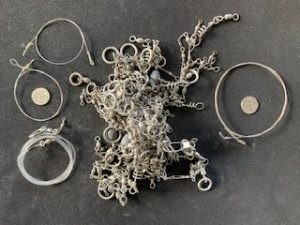Abandoned Fishing Gear Poses Major Marine Environment Problem

Marine debris on Hawai‘i coastline. PC: NOAA marinedebris.noaa.gov/marinedebris101/photos_ecosys.html, Public Domain, commons.wikimedia.org/w/index.php?curid=3834865
The 79,000 metric tons of plastic floating between Hawai‘i and California in the Great Pacific Garbage Patch—the world’s largest collection of floating trash—is mostly comprised of abandoned fishing gear, sometimes called “ghost gear.”
Fishing nets alone make up 46% of the garbage patch and the rest is comprised of ropes, traps, crates, baskets and other fishing gear.
Many may assume the fishing industry is to blame, but studies show that only 20% of ocean pollution is linked to commercial fishing and other marine-based industries.
Land-based sources, such as litter from beachgoers and shore fisherman, are to blame for the remaining 80%.
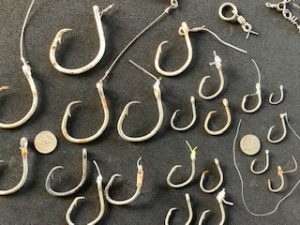
Hooks retrieved from Hawai‘i waters by divers (quarters for size comparison). PC: William De Rooy of Nautilus Dive Center
Also, contrary to popular belief, fishing gear is a bigger problem than consumer plastics such as plastic bottles. This pollution is one of the main environmental threats to our oceans, along with rising sea levels and global climate change.
Monofilament (common fishing line) is known for entangling marine animals since it is difficult for them to see, resulting in them being strangled or starved to death. It is also non-biodegradable, which means it will continue to take its toll on ecosystems year after year. It often ends up in the ocean after someone’s hook gets snagged or a fish large enough to break the lines takes the bait.
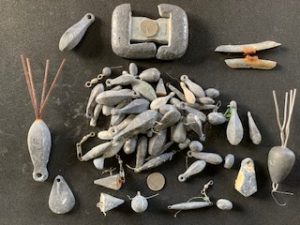
William De Rooy has collected hundreds of pounds of lead weights off our shores. This was all collected in the time frame of one year. PC: William De Rooy of Nautilus Dive Center
It is also very common for creatures to ingest the line. One sea turtle was found having consumed nearly 600 feet of heavy duty line.
Over 275 different species have been found to be entangled in marine debris; 46% of them were marine mammals such as dolphins and whales.
In addition, marine debris is harmful and expensive for humans. Not only does it often get caught in outboard motors and propellers, causing expensive repairs, but studies have also found that 19% of predatory fish ( including species commonly consumed by people) had ingested marine debris—when we eat these fish, we, too, are eating plastic.
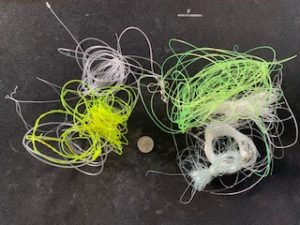
The balls of line collected off our shores can get up to 100 yards long. PC: William De Rooy of Nautilus Dive Center
William De Rooy, the owner of Nautilus Dive Center in Hilo since 1982, shared his concerns over shore fishing.
“The worst debris is the stuff related to fishing,” he shared. “One problem is that the state isn’t following up on the size-limit abuse. People are taking baby fish. When you take baby fish, it is one of the worst things you can do to the environment because the fish won’t grow to an age where it can reproduce.…. The state should increase enforcement. I frequently see violations of game laws”
De Rooy said the state also lacks enough no-fishing areas in the eastern waters of Hawai‘i Island like exist on the Kona side.
“On this side, we have none,” said De Rooy. “My experience over and over is that you can’t have a sustainable population of fish without some kind of conservation.”
De Rooy expressed concerns over fish populations since he first started diving.
“Both populations of fish and turtles have diminished,” he said. “I’ve been diving over 30 years. I would say I’ve seen a drop in over 70% of the population.”
“People think the ocean is a bottomless pit,” said De Rooy. “It is not like that. I have seen some sections of line that are over 100 feet long. I’ve done over 15 rescues of large turtles that have embedded hooks on their flippers or their shoulders. It is sometimes very difficult to conduct the rescue because the turtles are very strong—so people should not attempt rescue them without some kind of training. They should get experts involved. If they have something to cut the line, the hook causes minimal damage compared to what the line can do. I’ve seen several times where the turtle has lost a flipper.”
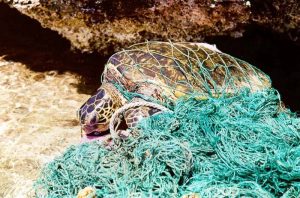
Turtle entangled in marine debris (ghost net). PC: www.noaanews.noaa.gov/stories2005/s2429.htm, Public Domain, https://commons.wikimedia.org/w/index.php?curid=3792337
What can be done about the problem?
“Fishermen need to be educated,” said De Rooy. “I’ve seen news articles frequently about ensnared manta rays, dolphins and whales. They need to get a license and pass a test to get that license.”
De Rooy believes schools should integrate more information about protecting ocean resources into their curriculum.
All fishermen should always properly dispose of their line as well as any line they encounter. Before disposing of the line, cut it up into tiny pieces to reduce the chance of animal entanglement.
Even if line gets tangled in the mangroves after a miscast, make sure the line ends up in the garbage where animals can’t take it out so it won’t end up blown back into the ocean.
Report stranded or entangled marine animals by contacting NOAA or contact the DNLR at (808) 587-0405 or send an email. The local number to report violations and hazardous ghost gear is (808) 974-6208.
DeRooy believes one of impactful things that needs to be done to make a difference is add more Marine Life Conservation Districts (MLCD).
“With the loss of the Kapoho Tide Pools to the recent eruption, the Island of Hawai‘i lost the only MLCD on the east side of this island,” De Rooy said. “We need to create more protected areas around the island.”



